Description
“The interface is deep and powerful, and the drones and ambiences you can come up with are seemingly limitless.” – Computer Music magazine![]() “Shortwave sounds amazing… Thanks so much, and keep creating inspiring stuff”
“Shortwave sounds amazing… Thanks so much, and keep creating inspiring stuff”
– Jonsi, Sigur Rós
“Shortwave is crammed with ghostly voices, radio tuning sweeps, Morse code bleeps, crackles and pulses… Prepare to be captivated by mysterious numbers stations, disembodied wails, warbles and mangled snippets of exotic chatter drowned in a sea of cosmic static.
These are noises harvested from the amazing sonic resource that is shortwave radio. Many of these noise sources could become energising backdrops for your otherwise pristine, in-the-box musical output” – Sound on Sound magazine![]()
![]()
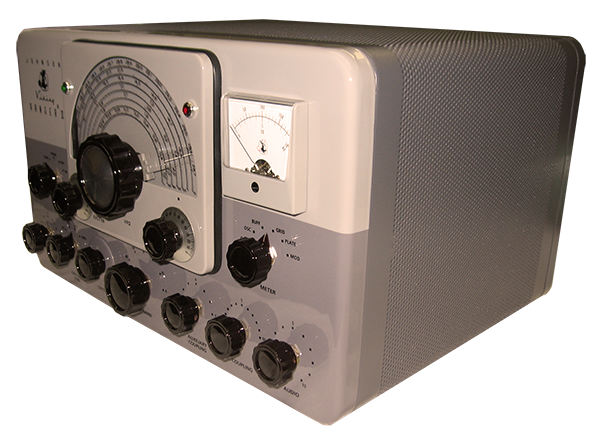 Somewhere out there in the night sky, lurking between the signals, are the real sounds of shortwave radio: the tuning squeals and howls; the strange, pulsing, stuttering waveforms; the cyclic, droning hums; the hiss and roar and crackle of cosmic radiation hitting the ionosphere. They have a strange and compelling power, calling to us, luring us further and further out…
Somewhere out there in the night sky, lurking between the signals, are the real sounds of shortwave radio: the tuning squeals and howls; the strange, pulsing, stuttering waveforms; the cyclic, droning hums; the hiss and roar and crackle of cosmic radiation hitting the ionosphere. They have a strange and compelling power, calling to us, luring us further and further out…
And then there are the disembodied voices, auditory glimpses of ham radio operators in dusty attics, forgotten cold-war numbers stations broadcasting codes to embedded spies, late-night broadcasts from a hundred countries all vying for a scrap of bandwidth to call their own. We’ve sought them out and brought them home.
Shortwave is a chaotic, randomised, unconventional soundscape-generating synthesiser. It allies a four-operator additive synth engine based on analogue, unstable sine waves to two “interference generators” that bring the power of the uncharted shortwave spectrum to bear on your sounds. It excels at unusual, drifting, evolving textures, pads infused with the background hiss and atmospheric static of the aether, and cinematic ambiences that pull you away from the normal and out into the upper atmosphere. It’s a strange beast, that’s for sure.
Shortwave patches are built from two key sections. First of these are the four Sine generators: one Fundamental and three Harmonics. These can be adjusted in pitch and level relative to each other, increasingly randomised using dedicated random LFOs, or locked to cyclic variations imparted by the Periodic Fluctuation generator, which acts as a master LFO across all the sines. The Fundamental can be distorted, giving it further triangle-wave-style overtones, and by carefully tuning the Harmonic waves, a crude approximation of different classic synth waves can be managed.
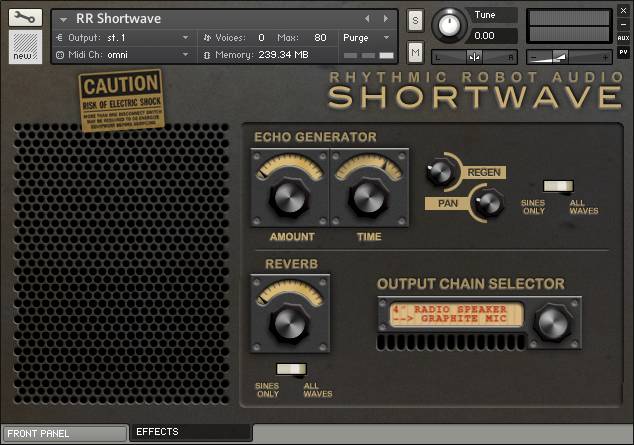 But to treat Shortwave as a conventional synth is to miss the fun part. The second section of its sound generation engine comprises the two Interference Generators. Each of these selects between 111 long, looped samples of “interference” – everything from basic hiss and noise, through periodic, cyclic effects, to tuning squeals and shrieks; voices, numbers stations, and Morse code signals; distorted carrier waves, strange atmospheric anomalies, and other tonal weirdnesses. These can be blended into the sound, and subjected to their own Randomisation controls, which randomly vary their amplitude independently of the Sines, fading them in and out of the range of hearing in a totally organic way. These long samples – usually between 20 and 30 seconds each – have randomised start points, so repeated notes will key the sample from a new point each time, adding further to the complexity and non-repeating character of the waveform.
But to treat Shortwave as a conventional synth is to miss the fun part. The second section of its sound generation engine comprises the two Interference Generators. Each of these selects between 111 long, looped samples of “interference” – everything from basic hiss and noise, through periodic, cyclic effects, to tuning squeals and shrieks; voices, numbers stations, and Morse code signals; distorted carrier waves, strange atmospheric anomalies, and other tonal weirdnesses. These can be blended into the sound, and subjected to their own Randomisation controls, which randomly vary their amplitude independently of the Sines, fading them in and out of the range of hearing in a totally organic way. These long samples – usually between 20 and 30 seconds each – have randomised start points, so repeated notes will key the sample from a new point each time, adding further to the complexity and non-repeating character of the waveform.
The majority of the 111 Interference waveforms were recorded by us, in an attic, with a 60-foot antenna loop and a real-life shortwave receiver, over a series of long nights where we searched for the strangest things the airwaves had to offer us. We found genuine, functioning numbers stations, cranking out spy code in robotic voices with Russian accents; we stumbled through CB radio conversations and Marxist governmental propaganda; we heard voices from the far sides of the world. It was magical. Some of these samples are presented unaltered, and some were high-pass filtered to take out the rumble (look for the HPF note in their Interference Generator names). Then we also recorded a set of samples from our ever-growing modular synth, getting “pure” white and pink noise, and roping two Manhattan Analog MA-35 analogue filters together with two Doepfer random CV generators and making them fight it out. The resulting squeals, howls and groans are there for the taking too, though they’re labelled in green to distinguish them from the authentic radio waveforms, which are listed in black. (In the main screenshot above, there’s one genuine shortwave radio sample that’s been high-pass filtered loaded into Interference slot 1, and a modular version of static noise in slot 2.)
 Lurking in the top right-hand corner of the UI is our neat little Glitch button: your one-stop shop for new inspiration. It’s a “musical” randomising control, which means that clicking it randomises the whole interface, generating an entirely new sound – but with a bit of clever maths predisposing the randomising towards “musically useful” results. (For example, the Glitch command only randomises the Fine tuning controls every once in a while; so most of the time, the patches it generates will be musically harmonious… broadly speaking.) Clicking away at the Glitch control tends, in our experience, to yield something genuinely useful and inspiring pretty often – once every 10 clicks or so is our guesstimate – and it’s a great way to take your sound design in an unthought-of new direction, or break a creative block.
Lurking in the top right-hand corner of the UI is our neat little Glitch button: your one-stop shop for new inspiration. It’s a “musical” randomising control, which means that clicking it randomises the whole interface, generating an entirely new sound – but with a bit of clever maths predisposing the randomising towards “musically useful” results. (For example, the Glitch command only randomises the Fine tuning controls every once in a while; so most of the time, the patches it generates will be musically harmonious… broadly speaking.) Clicking away at the Glitch control tends, in our experience, to yield something genuinely useful and inspiring pretty often – once every 10 clicks or so is our guesstimate – and it’s a great way to take your sound design in an unthought-of new direction, or break a creative block.
Finally, round the back, we have some ear candy to bring your patches to life still further. The Echo Generator can produce conventional echoes, or be tuned ridiculously tight for more mechanical, ringing, distorted effects. The Reverb control patches in a custom convolved Plate reverb sample. Both of these effects can be applied to the whole sound, or just the Sine operators, which usually yields a more musical result (most of the time, echoing and reverbing up the Interference Generators just results in a noise-roaring mush of sound… though sometimes that’s what you want!)
The Output Chain selector harnesses eight combinations of speakers and microphones, ranging from full-range studio monitors and condenser mics through to nasty little 3-inch radio speakers and a wonderful old-school graphite mic (the same technology that powered the telephones of forty years ago). This is where you can take those full-range Sines and make them sound like they’re coming from a battered old Radio Shack receiver.
All in all, Shortwave is a strange, wonderful, sometimes unnerving, sometimes ethereal addition to your synth arsenal. It can surprise and captivate you, moving from raw, crackling energy one moment to distant, shifting echoes the next – just like tuning a shortwave receiver! As a source of pads, washes and drones, it’s pretty much guaranteed to out-weird any other synth. Shortwave – time to go on the air…
(All our Kontakt instruments require a full copy of Native Instruments Kontakt v4.2.3 or higher (including all versions of Kontakt 5). Kontakt Player is not supported: instruments will load, but will time out after 15 minutes. See the FAQ for further information.)
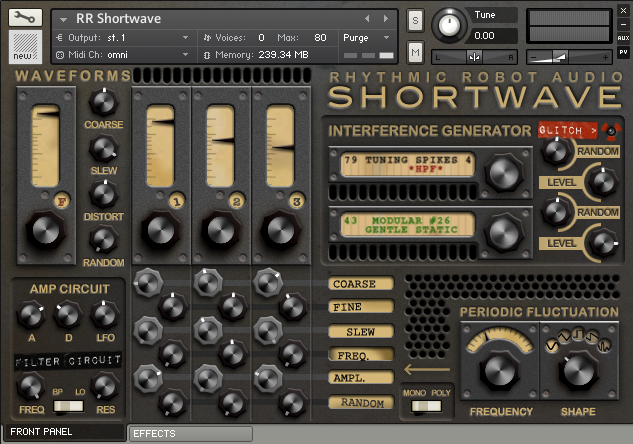
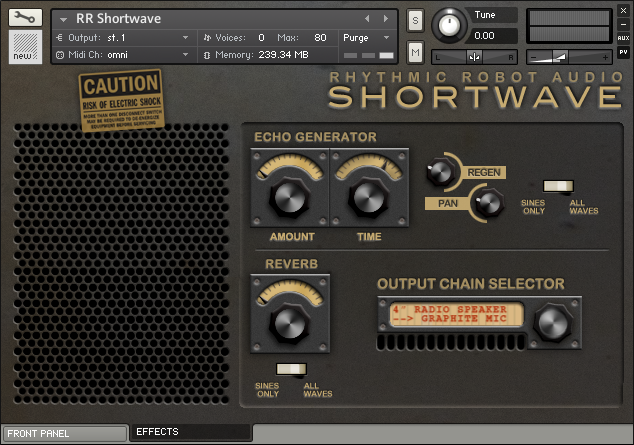
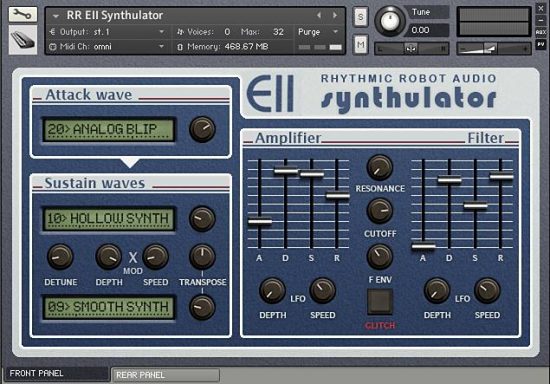
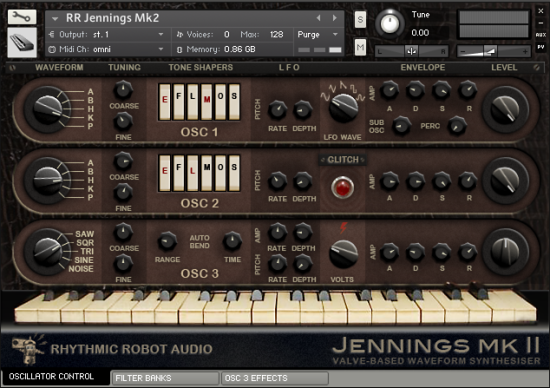
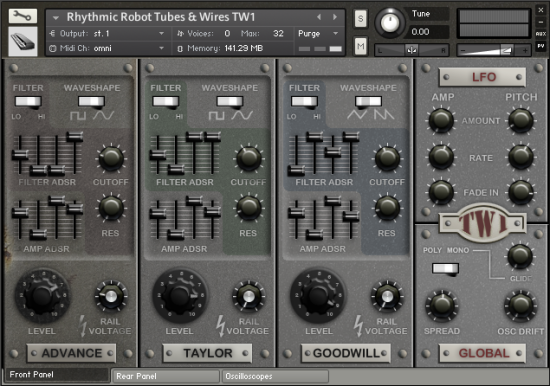
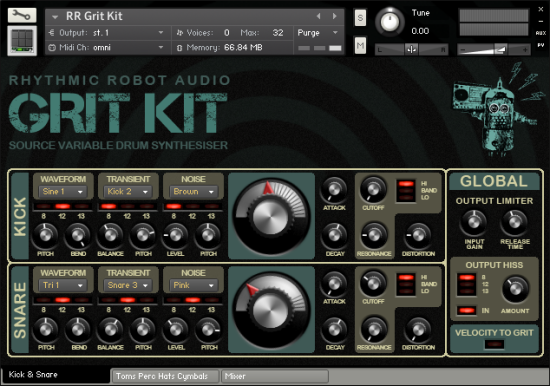
HypersonicNinja (verified owner) –
This is possibly my favourite RR instrument. and is just utterly fantastic. As others have said, it just adds something so wonderfully haunting and ethereal. Browsing through the presets was an education in itself: I’d never previously heard of a “numbers station” and literally an entire galaxy of sonic possibilities opened up. It can generate atmospheres of mysterious tension, otherwordly enigmas and unknowable voices chattering through the void. However, it can also generate suprisingly intricate leads and this is one thing that I think it really shines at (the presets “Synth – Granular Timpani” and “Synth – Overlord” illustrate this well). I seem to unearth something wonderful within a few minutes’ of trying the randomise function, too. In summary, worth every penny – and thank you to RR, I now want to buy a SW radio and listen to the sounds of numbers stations broadcasting their relentless codes through the night….
JAMES (verified owner) –
Want to know what the Professor and Mongo are all about? This is exhibit A… Many RR instruments can be called haunted, but this sucker is HAUNTED. It’s an audio version of a good X-Files episode with every push of the “glitch” button. It is sick and twisted and I love it. Oh, and it can also do relatively “normal” and useful as the range of presets can demonstrate. I’ve used this in a live improv setting and scared the crap out of people, if you fade it in and out as you press the “glitch”. Don’t say you weren’t warned…
mightbeacoolusername (verified owner) –
This is a special kind of feeling, like its late at night and you, driven by insomnia, are sitting up by the light of a single dim and flickering bulb seeking out something you didn’t know about before. Somehow, though, it still manages to be hugely versatile! Are your leads boring? Pads murky? Bass limping? Slap a little Shortwave on it, the aural fantasia effect will fix it right up.
W.TaylorRiley (verified owner) –
Additive synthesis is probably my favourite type of synthesis. I’m sure most people would think “radio interference is already so noisy we can’t add much more” but RR goes the opposite way and wants you to mangle to everyone. I swear they’re just trying to build the ultimate multi rack for Kontakt. Everything I get from the Prof and Mongo I can hear blending together for the ultimate sounds. I’ve already made a few presets of multis!! RR really is for the community and inspire me wholeheartedly.
Lee (verified owner) –
Totally unique and one of my favorites. You get an instant Yankee Hotel Foxtrot feel once you place this on a track. Like nothing else I own.
aqaraza (verified owner) –
Shortwave is my first RR instrument. I can tell I’ve only seen the tip of the iceberg, but what this instrument can do is incredible. The ream of shortwave audio is indeed so mysterious and alien to our modern ears that it feels as if the instrument opens sonic portals. It makes me wonder what an RR instrument that applied the same approaches to a bank of one’s own samples would be capable of. And it makes me that much more excited to explore the other instruments they’ve created.
The organic depth to the sounds produced is something that is rare and beautiful to find in any software instrument, but the way they allow for limitless (yet useful!) exploration via the Glitch switch is a game changer. I look ahead at the list of RR instruments I’m interested in here, and see how many of them also have a Glitch switch, and I become a little bit afraid. In the best possible way.
Randomization is nothing new (though is used far too infrequently for the flood of choices we’re immersed in). But the way RR is so clearly dedicated to coaxing subtleties out of the sounds it creates instruments around is heartening and exciting. I know that ahead of me lie instruments for which multiple samples of seemingly the same tone or beat have been taken, and velocity added, to coax that much more richness out of the analog tones. But for now, Shortwave is a wonderful doorway into a deep and subtle world.
michael.topic (verified owner) –
Ever since Thomas Dolby’s “The Golden Age of Wireless”, I’ve been drawn to the combination of synths and shortwave radio. This instrument isn’t quite so blatant, but it definitely injects the feel of distant long wave broadcasts. If your aim is to suggest another place and time, without being overt about it, these sounds get you there. There’s always enough going on to keep your ears from getting overly familiar with the tones. Great colours for any audio soundscape.
Monika Edvardsen (verified owner) –
All the times I’ve browsed the RR pages, I’ve never even clicked on this one, thinking it was just sounds of tuning between radio channels, so I was pleasantly surprised when I checked it out and found out it was a strange “synth” (with radio sounds). It’s got one main sine tone, three more sine tones with pitch LFOs and two radio sound sources. Together they produce loads of weirdness and fun. Swapping one of the sine waves with a celeste sound also sounded magic (needed to switch the group to DFD because of scripted random sample start).
As with quite a few other RR instruments, there are unfortunately two knobs that don’t work properly: The RANDOM knob for Interference wave 2 doesn’t do anything, and the Attack knob works for the pitch of the three 1st sine waves, but not the 4th one.
The Professor (verified owner) –
We’ve had a close look, but can’t find the two issues you mention. As far as we can see, the Random knobs are all working properly (ie, introducing random fluctuation), and the Attack knob works as it should also. Could you drop me an email to check it through in more detail? Thanks!
mrianrjohnson (verified owner) –
This is almost too out there – which is no mean feat compared to RR’s normal output. That said, I LOVE the sound of the number stations – instant crusty creepiness to any track!
pbrmei (verified owner) –
Looking to add background mystery to some tunes? Look no further! Thanks again RR!
Bo (verified owner) –
Absolutely crazy good. So inspiring. This is what makes making music fun.
brianedwardpoe (verified owner) –
I have now embraced the accidental misfortune of having initiated a key interval with the precise MIDI data that played back the distinct sonic signature of a Mi-Go communicating with Clark Nova typewriter. I will report back later of their nefarious plans against NPR.
Chris (verified owner) –
There is nothing else like this. Even by RR’s standards it’s on the weird side! If you want out there, spooky, crusty, wonky and unearthly textures, you’ll find them pouring out of this thing!
Stefano (verified owner) –
Great product, Shortwave is able to reproduce all sounds and noises of an old shortwave radio, with the advantage that this radio can sing… like a ghostly theremins quartet conducted by Mongo!
Takoda.Castillo.23 (verified owner) –
Shortwave is no short on awesome sounds! It can be used by itself to create interesting sounds, or used in combination with other sound sources to add unique texture and overtones. I like being able to isolate the individual sound sources.
Michael Holloway (verified owner) –
Shortwave is exactly what I was looking for (and more). Really wonderful sample content, along with retro radio-phonic style tweak-able synths… incredibly atmospheric stuff! I also really appreciate how configurable everything is, with mix controls the samples / synths all made independent, you can really hone the overall sound to your needs. This is the instrument that sold me on Rhythmic Robot — masterfully crafted stuff!
Renato –
Spoooooooky!
Philip –
Wonderful sounds
Hugo –
Huge sound and powerful oscillators make this synth really interesting. This wide ra
Martin –
This instrument leaps to life when you assign knobs on your MIDI controller to it, you can create beautiful evolving pads. If you like “Radio Cure” by Wilco, it’s right up your alley. You could probably make a whole album with nothing but Shortwave!
Gerard (verified owner) –
Once I got some issues with PayPal credit dealt with (which are completely PayPal’s fault, and the Professor and Mongo helped as much as they could), I was immersed into a world of bwoops and garbled voices!
Perfect for adding that touch of air to a track that’s missing some grit, or even as a foundation for a new sound thanks to the GLITCH button – a bolt of inspiration on demand.
I also see a ton of possibilities with the faded out nature of the synth suggesting use as a counter melody – might just learn counter point to harness this potential.
ben johnston –
When I first saw this I couldn’t believe someone was making a plugin that was such a close fit for what I’d been looking for. I like spooky 60s style electronica/pop, and this is perfect for adding radio tuning sweeps and dynamic loops of static and mumbling voices for special effects, transitions and background ambience. Gives you a lot more flexibility and movement than just using individual samples because of all the blending options and parameters to tweak. As well as special effects and scary noises there’s also a lot of options for more traditionally synthy sounds that still have a unique character – the presets cover a lot of territory and give you an idea of how versatile it can be. The glitch feature is also a great way to explore what’s available and find something unexpected.
If you’re looking for something spooky, atmospheric and very, very analog, Shortwave is definitely worth grabbing!
Robert (verified owner) –
Sometimes I just sit there and listen to the distant voices.
Joe –
It’s hard not to want all of the items in the RR catalogue, but if you have to choose I can easily say this is one of my favorites. The sounds instantly transport any listener into some other realms of the imagination.
Jacob (verified owner) –
As time passes, I’m starting to realize that me and Rhythmic Robot are more and more developing a shared wallet. As soon as the monthly salary is in, I can’t help but surf my way to their site and look at which quirky instrument I’d like to buy next. The good news is, the pricing is always reasonable enough, so their library of instruments is actually something that I can afford exploring. And that exploring sure is a pleasant experience.
The competition is tough, but Shortwave is the instrument of their’s that stands out the most in my eyes. Mind you, this isn’t an instrument that’s trying to be a jack of all trades. It’s obviously not going to fullfill all the roles in your production. It doesn’t want to. But, for the things it want’s to do, it does perfectly, and I’m finding it harder and harder to replace. Some obvious applications would be making gritty lo-fi pad textures and Boards of Canadesque leads. Other applications are purely related to sound design. In the right amount, Shortwave makes some great post-apocalyptic soundscapes fitting extremely well in video game worlds, and I can’t help but thinking of Fallout whenever I fire up Shortwave. And if you are short on inspiration in your music production endeavours, McDonald’s is of course hiring, but it might be more efficient and less dreamshattering to just fire up Shortwave and hit the Glitch button untill you find some sonic material to fall in love with, and your back on track.
Buy this for you and for your friends, and then buy it a couple of times more. It’s that good. Seriously, do it now.
Ley –
I spent a portion of my childhood in the attic listening to my father’s shortwave radio, which I still inexplicably own despite its sorry state. Thank goodness for the Professor and Mongo having brought out this instrument. Just pressing one key takes me back to that warm glow and clear sense that there was something more ‘out there’. Musically beyond that, this is now my ‘room tone’ of choice for so many projects. Even at an almost subliminal level, this give any track that patina of age it could require.
Sascha –
the first of a series of instruments I got from this site. yes, I bought several of them. need to say more? awesome instrument for example for adding a special atmosphere into a silent part of a song. wouldn’t want to miss it, now that I have it.
Shaun (verified owner) –
This thing is great for adding disturbing but subtle background noise and unstable pads to tracks. The muffled samples of voices are my favourite, and I have to stop myself from putting them on everything. I’m working on a project where I need to create slow dreamy atmosphere and this thing is invaluable for that.
Kenny Garlic –
Of course, the honored industrial music maker proudly personally samples old VHS or radio sources… … but for the moments when time is money, or just for an extra creativity boost, this thing is priceless for adding just the right kind of disturbing, unstable, odd background, no matter whether you´re working on an ambient track or follow the old school Skinny Puppy vein.
Jörg –
I several times was looking for something handy like this.
If you are looking for athmospheric and grainy radiowaves that are
very customizeable, this is it.
shocker –
Unbelievably creative… Very cool, very interesting!
Bene –
This is one of my favourite Plugins so far. It’s really easy to dial in ambiences for a track or just use it as a noise source!
oneish –
Cool sound effects plucked from the ether.
Antal Nusselder –
This was exactly what I was looking for for suspenseful, ambient background sounds and noises. I used it a bit on out latest album and plan to do so a lot more in the future.
Matt Gutteridge –
Shortwave is totally worth it if you’re into experimentation or weird sounds – and extra worth it if you’ve ever been a fan of 70’s era Sci-Fi or um, Scooby-Doo. I’m pretty sure my computers haunted now from all the g-g-g-ghosts! Aside from the haunts, every other time I hit a key I feel like a retro space traveler – so that’s also cool. It sounds great when at the forefront of the mix, on it’s own and it’s equally useful for background textures. I’ve used it effectively as a background that would add some dirt, and then I’d stop it to accentuate the clean sound of everything else going on, and keep alternating. You can hear this example here – it switches off to make the mix sound extra squeaky clean at 32 seconds:
https://soundcloud.com/noiseabroad/reflections
The Professor (verified owner) –
Just wanted to say, Matt, that track is absolutely awesome 😀
J.david franzke –
if you ever have the need to throw out that shortwave radio you own and truly let go and have a religious experience here be your mighty holy grail o salvation. AMEN